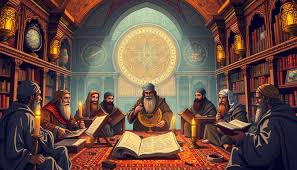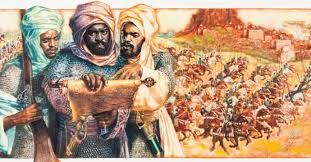The history of Islam saw a period of scientific, economic, and cultural progress during the Islamic Golden Age. Starting from the 8th Century, the vast Islamic Caliphates dominated this period, stretching from Al-Andalus in the west to the Indus Valley in the east.
Once the language of scholars, theologians, and easterners, Arabic, not English, has become the lingua franca worldwide. Over many centuries, it has become the dominant language in education, trade, diplomacy, and science. This is not the world we know; it is a time blast to a world where the Islamic Golden Age never ended, and Arabic became the dominant global language.

The 8th Century began with the Umayyad Caliphate pushing deeper into Western Europe, crossing the Pyrenees and overwhelming the Frankish resistance at the Battle of Tours in 732. At the time, Latin was a dominant language, mainly because of the Roman Empire’s prowess. However, Latin was gradually replaced by Arabic, and scholars from across Europe flocked to the great libraries of Al-Andalus to study philosophy, medicine, and mathematics in Arabic.
Simultaneously, in the east, the Abbasid Caliphate kept expanding, conquering, and gaining territories. It expanded beyond the Indus River, merging the Indian subcontinent into the Islamic world. Expanding into India was almost seamless, as the synergy between Indian and Islamic traditions created unparalleled integration.
With the Caliphates controlling vast and diverse territories, Arabic scholars started making waves as the language became the primary medium for scholarly discourse. Notable scholars like Ibn Sina and Ibn Rushd played a major role in interpreting the works of Aristotle and other philosophers from Latin to Arabic.
Arabic prose and poetry also dominated Literature, with epics like One Thousand and One Nights, an anthology of Middle Eastern folk tales, influencing storytelling worldwide. While Ibn Sina argued his “Floating man” thought experiment concerning self-awareness, renowned writer Ibn Tufail wrote the novel Hayy ibn Yaqdhan.
In response, Ibn al-Nafis wrote the novel Risālat Fādil ibn Nātiq. Similarly, Persian mathematician Muḥammad ibn Mūsā al-Khwārizmī played a significant role in the development of algebra, arithmetic, and Hindu–Arabic numerals. Since the printing press was invented in the 14th century, Arabic texts—ranging from Ibn Sina’s medical treatises to Al-Khwarizmi’s algebraic formulas—have spread worldwide.

Under the reign of the Abbasid caliph Harun al-Rashid (786 to 809), with the inauguration of the House of Wisdom, scholars from all over the Muslim world flocked to Baghdad, the world’s largest city. Advances in medicine, astronomy, and engineering flourished under the House of Wisdom in Baghdad, now with satellite institutions in Florence, Delhi, and Marseilles.
The Renaissance saw a global Arabic-led revival of knowledge. Before civilization crept in, by the time of the Industrial Revolution, Arabic had cemented itself as the primary language of education and governance.
In 1969, when the first human set foot on the Moon, the words etched in history were Arabic, and read: In the name of Allah, we explore the universe. Nations worldwide, including the Americas, were colonized not by European empires but by a technologically advanced Islamic world. The Caliphates made sure their colonies adopted Arabic, ensuring its dominance well into the modern era.
While countries like France and Italy tried to fight their Islamization, the Caliphates, with their mighty army and exceptional battle skills, overpowered them. They ensured Arabic became the dominant language in those countries, which resulted in the regional varieties of the Franco-Arabic and Italo-Arabic dialects spoken in France and Italy today.
Like most things, the global culture in the 21st Century is deeply rooted in Arabic traditions, with Sharia Law taking a center stage. Nobody has a reason to debate their pronouns, and the only recognized sexes are male and female. From Washington, D.C. to Beijing, Arabic calligraphy adorns government buildings. Even the digital age is shaped by Arabic, as programming languages derive from Arabic syntax.
While some adhere to Christianity, traditional Arab dress is the accepted official dress code. Male lawmakers and professionals wear the thobe and keffiyeh, while their female counterparts wear the abaya and hijab. English, Latin, and other European tongues survive as regional dialects, but to engage in business, science, or diplomacy, one must learn Arabic. International law is also debated in Arabic at the United Nations.
The Islamic calendar dictates international trade and politics, with Ramadan serving as the global holiday season. Since most of the world’s population, from the Atlantic to the Pacific, is fasting, the 30-day period is more or less a period of hibernation for everyone; normalcy returns after Eid al-Fitr.
The Islamic Golden Age continues to flourish with no end in sight. However, one thing is certain: Language shapes civilization, and in this world, Arabic is its heartbeat.
You Might Also Like:
The Roman Empire Latinizes the Entire World
The Rise and Fall of the Mali Empire


